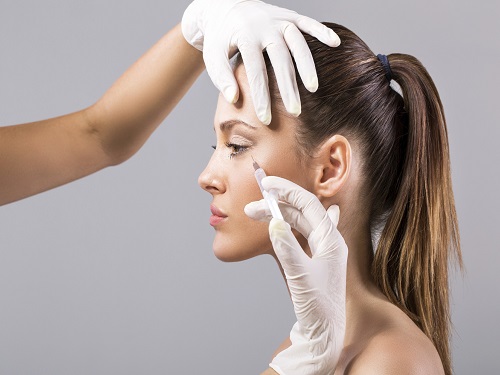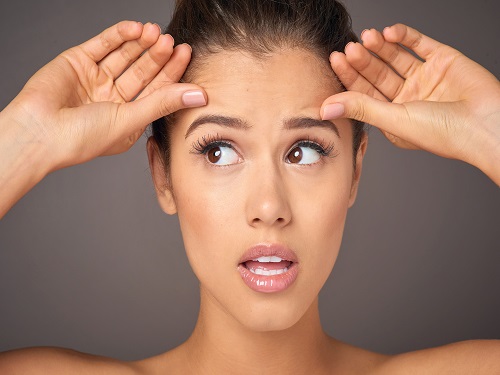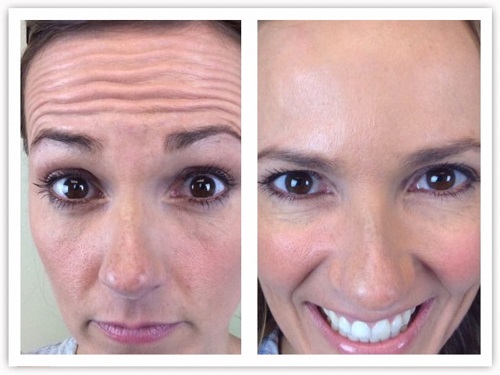Overview
ToggleBotox Injections
In this article, we will explain what Botox is, how it works and explore its uses, side effects, and other risks.
You might have noticed fine lines and wrinkles appearing on your face while looking in the mirror. Or when looking at recent photos of yourself, you have started to wonder, “do I really look that old?”
Ageing is an inevitable process, but fortunately it is now easier than ever to restore that youthful glow without surgery. Botox is one of the most popular cosmetic treatments administered to millions of beauty seekers every year. Both men and women have impeded the ageing process by diminishing wrinkles using Botox injections.
What is Botox?
Botox is a brand name for a neurotoxin derived from the bacterium Clostridium botulinum. There are currently four different types of FDA-approved brands for cosmetic facial wrinkles including Botox, Xeomin, Dysport and Jeuveau. Botox is the term you hear most often because it was the first injectable botulinum toxin.
Botox is used for three main purposes:
1- Cosmetic and aesthetic goals
2- Severe underarm sweating
3- Muscle spasm control (in medical conditions)
Botox contains botulinum toxin type A (the active ingredient), human albumin (a protein found in human blood plasma) and sodium chloride.
How Does Botox Work?
Some types of wrinkles on the skin are typically formed when the muscle located directly beneath them contracts. For example, the muscle in the forehead is a vertical one, and when it contracts (such as when you raise your eyebrows), the wrinkles will be formed horizontally. Likewise, the two muscles that are responsible for the frown lines (vertical wrinkles between the eyebrows) are positioned slightly horizontally between the eyebrows, so when they contract, the frown lines appear vertically.
The substances in Botox target the nervous system, disrupting the nerve signaling processes that stimulate muscle contraction. This is how Botox causes temporary muscle paralysis.
By injecting Botox into the muscles responsible for certain movements, you won’t be able to make certain facial expressions, so the wrinkles won’t form. The most common use of Botox injections is to temporarily relax the facial muscles that cause wrinkles in the forehead, around the eyes (crow’s feet) and frown lines. Unfortunately, Botox won’t help with wrinkles caused by sun damage or gravity. Facial lines that exist when your face is totally relaxed are not good candidates for Botox either. These lines are better handled by the dermal fillers. Botox can “soften” these lines but cannot eliminate them completely.
Your practitioner can help you decide which product(s) will solve your particular appearance concerns, though as a general rule, Botox is used mostly in the upper portion of the face, and fillers are used mostly in other areas.
Cosmetic Uses of Botox
The primary use of Botox is reducing the noticeability of facial wrinkles. According to the American Board of Cosmetic Surgery, Botox injections are the most popular cosmetic procedure nationwide.
People often request the injections in the following areas of the face:
- wrinkles between the eyebrows (frown lines)
- wrinkles around the eye (crow’s feet)
- horizontal creases in the forehead
- lines at the corners of the mouth
- “cobblestone” skin on the chin
However, the FDA have only approved the injections for use around the eyes and on the forehead.
Healthcare professionals also use Botox to treat a variety of medical conditions, most of which affect the neuromuscular system. Anyone who believes that Botox might help them with a medical condition should speak with their doctor.
A number of these medical conditions are listed below:
- Cervical dystonia which is a neurological disorder that causes severe neck and shoulder muscle spasms
- Eyelid spasms (blepharospasm)
- Eyes that point in different directions (strabismus)
- Chronic migraine. Botox may help prevent migraines in people whose headaches last at least 4 hours on for 15 or more days per month.
- Eye twitching
- Muscle contractures. Some neurological conditions, such as cerebral palsy, can cause your limbs to pull in towards the center. In some cases, these contracted muscles can be relaxed with Botox injections.
- Lazy eye. The most common cause of lazy eye is an imbalance in the muscles responsible for positioning the eye.

Hyperhidrosis is the medical term for excessive sweating caused by overactive sweat glands. The United States Food and Drug Administration (FDA) have approved Botox injections to treat this condition. It works by blocking neurotransmitters in the body that activates the sweat glands, to control sweating in the injected area.
People should seek medical help if they experience excessive sweating around the groin or feet which dispose the area to bacterial or fungal infections. Also the feeling of embarrassment and avoidance of physical activities, motivates patients to look for solutions such as Botox.
According to the International Hyperhidrosis Society, underarm Botox injections can reduce underarm sweating by 85%. The effect can typically last 4–12 months, or even up to 14 months in some cases. However, Botox is not a permanent solution for excessive underarm sweating, so patients need ongoing injections. Those who receive underarm Botox injections usually see results 2–4 days after treatment. The full effect is usually noticeable within 2 weeks.
Pros and Cons of this method
The advantages of this treatment is being:
- effective
- relatively long-lasting
- relatively painless
- less invasive than surgery
On the other hand, the drawbacks to consider are:
- expensive cost
- temporary effect
- potential side effects
- only approved for underarm sweating
A person who experiences excessive sweating can talk to their doctor for advice on the most effective treatment.
Using Botox on other parts of the body
To date, the FDA have approved Botox injections for underarm use only. However, doctors may prescribe the treatment for excessive sweating elsewhere on the body, such as:
- Hands
- Feet
- Back
- chest and under the breasts
- groin
- head
- face
Botox treatments on hands or feet tend to be less effective, and are more likely to cause side effects. The procedure can also be more painful in these areas. Experienced dermatologists can also use Botox to treat sweating of the face, groin, or breasts.
What to Expect
Before the procedure
Consultation with an expert dermatologist before the procedure is a must. They should take this opportunity to tell the doctor about any medical conditions they have, and the medications they currently take. This can help reduce the risk of side effects and complications afterwards.
Your face will be cleansed and the areas that are to be injected will be marked with a removable eyeliner/marker. Any injection can hurt, but the needles used for Botox injections are very small, so the pain is usually minimal. However, you may want your skin numbed beforehand, especially if your palms or soles are being treated for excessive sweating. Your doctor might use one or more than one of the methods available to numb the area, such as topical anesthesia, cold compress (10-20 minutes prior to the injections) or vibration anesthesia which uses massage to reduce discomfort. Once you are ready, the injections will be performed in various areas to target the desired muscles.
Here are a few notes to consider before your Botox injection appointment:
- avoid alcohol at least 1 week before the procedure
- stop taking aspirin and anti-inflammatory medications 2 weeks before treatment to help prevent bleeding and bruising
- Avoid taking blood thinners a week prior to your injection to reduce your risk of bruising
- Tell your doctor if you’ve had any type of Botox injection within the past four months.
- Also tell your doctor if you take muscle relaxants, sleeping aids or allergy medications.
- People who are planning to have Botox injections in order to treat excessive underarm sweating, should not shave their underarms for 3–4 days before the treatment.
During the procedure
Dermatologists can perform the injections in their office. Your doctor uses a thin needle to inject tiny amounts of botulinum toxin into your skin or muscles, with injection sites approximately 1–2 centimeters apart. The number of injections needed depends on many factors, including the extent of the area being treated.
After the procedure
You might have a few small bumps on your skin at the exact injection site but these will be gone by the time you leave your doctor’s office. You might also have some mild bruising which will resolve in 24-48 hours.
Below are some instructions on what to do and what not to do in the following weeks:
- Do not rub or massage the treated areas for 24 hours so you don’t spread the Botox to another area.
- Stay upright for 4 hours after the injections
- Don’t exercise for at least 1-2 days (Exercising increases circulation which can lead to your Botox injection going into other areas of the face)
- Avoid the sun or make sure you wear sunscreen to maintain your Botox results
- Avoid excessive facial movements. It’s recommended that you limit those expressions so your Botox results will last longer.
- You can return to your normal activities right after the procedure.
Most healthcare providers will recommend a follow-up appointment 1–2 weeks after the procedure. This is to touch up for any missed areas, and checking for side effects.

Results
In general, the effects of Botox appear within 3-5 days, but it is common not to see your full and final results for 7-10 days. The maximum effect usually occurs in about 10 to 14 days because the toxin takes time to block nerve impulses to the muscles. Therefore, any result obtained two weeks after the injection should be considered as the maximum result to be achieved.
However, the effects are temporary and last for 3 to 12 months, depending on the type of treatment. With a slow return of muscle, lines and wrinkles reappear and require re-injection. To maintain the effect, you need regular follow-up injections. There will certainly be patients in whom the results remain longer or shorter than the period mentioned above. Some of them have a longer effect with repeated use, while others seem to be resistant to the drug and need repeated treatments. Everyone has a unique experience and the results may be different.
Some critics say that Botox destroys your communication spirit and gives you much less range of motion when you laugh or get angry or upset. While it is true that your movement will be limited, a moderate amount of Botox will still allow you to react and communicate in a lively way.
The Cost of Botox
It depends on various factors including:
- whether it is for medical or cosmetic purposes
- who provides the treatment
- where the treatment takes place
- the number of Botox units involved
Risks and Side Effects
People generally tolerate Botox injections well, and side effects are uncommon. However, potential Botox side effects and complications include:
- Headache or flu-like symptoms
- Infection
- Eye dryness or excessive tearing
- Inflammation
- Pain, swelling or bruising at the injection site
- Redness
- bleeding
- Droopy eyelid or cockeyed eyebrows (It usually goes away within 3 weeks which happens when the Botox moves around, so don’t rub the treated area)
- Crooked smile
- Numbness as the result of the inability to move a muscle
- Dry mouth, fatigue, and neck pain
Some possible allergic reactions include itching, wheezing, asthma, rash and red welts.
Call your doctor immediately if you notice any of these side effects hours to weeks after receiving Botox:
- Muscle weakness
- Vision problems
- Trouble speaking, swallowing or breathing
- Loss of bladder control
- Dizzy feeling
Also, some people receiving injections of Botulinum toxin type A develop antibodies to the toxin that make subsequent treatments ineffective.
What are the risks?
Botox is a relatively safe treatment, but it should always be performed by a qualified medical professional to ensure that you are getting the correct amount in the correct area. Being administrated by someone without the correct qualifications and experience, could lead to asymmetrical results, muscle drooping, frozen expressions as well as various other dangerous consequences.
How to Avoid the Side Effects
The list of possible side effects mentioned in this article is a long one, but it would be extremely rare for anyone to experience all of them. Following these tips will minimize or prevent most Botox side effects:
- Make sure your practitioner is very experienced in Botox injections and is a respected medical professional. A salon stylist, for example, is not an appropriate person to administer Botox, because he or she would not have emergency equipment or sufficient medical knowledge if something goes wrong.
- Follow your practitioner’s pre- and post-injection instructions very carefully.
- Before having injections, tell your practitioner about any health issues you have. Tell your practitioner about medications, vitamins, or herbal supplements you take, since the combination of some of these supplements with Botox could cause serious side effects. It’s especially important to mention having taken injected antibiotics, muscle relaxants, allergy, cold medicines or sleep medicines.
- Report all side effects — especially those that are bothering you or won’t go away.

Who Should Not Get Botox?
In the United States, the FDA has approved Botox usage for people aged 18 to 65. But you shouldn’t use it if you:
- are allergic to any ingredients in Botox or other brands such as Myobloc, Xeomin or Dysport
- had any side effect from these products in the past
- are allergic to cow’s milk protein
- have a skin infection or other condition in the injection area on the day of your appointment
- have ALS (Lou Gehrig’s disease), myasthenia gravis, Lambert-Eaton syndrome or other diseases that affect your muscles or nerves
- have breathing problems, such as asthma
- have difficulty swallowing
- have bleeding issues
- plan to undergo surgery in 3 weeks or sooner
- have had facial surgery recently
Botox During Pregnancy and Breastfeeding
Botox is not expected to travel far enough through the body to affect the fetus or the breastfeeding mother’s milk. However, for ethical reasons, clinical studies have not been conducted on expectants or new mothers, so it is not known for sure.
Therefore, the manufacturers’ advice is not to have Botox injections if you are planning to conceive a child, are pregnant, are planning to breastfeed or are currently breastfeeding. It’s better to be safe, since you can always have Botox later on.
How often can you get Botox injections?
Most people report the results lasting for three to four months, but several factors may shorten or lengthen that period:
- The type of Botox used
- Your age. Older people with less muscle tone may see results diminish sooner than those with younger, firmer facial muscles.
- Your facial structure and expressions.
- Whether you smoke or not
- Your diet
- Whether you take good care of your skin; use facials, microdermabrasion or other resurfacing methods.
- How much sunlight your skin is exposed to and how much sun damage your skin already has.
Doctors disagree on which of the above factors are the most important. In any case, it is not recommended to have injections in the same injection site more frequently than every three months.
Facial muscles naturally weaken over time and going overboard in a certain area could have unwanted consequences. If Botox is administrated too frequently for many, many years, the muscles will get weaker and flatter. Moreover, as your muscles become weaker, they can start to recruit surrounding muscles when you make facial expressions. For example, if one stops using their forehead muscles, they may start squinting using their nose and have wrinkles along the sides of their nose. This leads to the need of even more Botox for the newly recruited muscles.
The wonder of Botox for each decade
Suitable for Botox patients in any age decade. Younger patients in their 20s use preventative Botox treatments to eliminate wrinkles. Patients in their 30s consider Botox to keep their skin looking young and fresh. Men and women in their 40s and 50s use Botox to restore their youth or rejuvenate their skin and reduce the appearance of wrinkles and fine lines. Botox can significantly improve a person’s overall appearance and even help delay the need for more aggressive cosmetic procedures for years to come.
What's the Ideal Age to Start Using Botox?
This varies and it’s mostly up to you! You don’t need it before you have wrinkles to hide, or you can use it preventatively. It is mostly about genetics and environmental factors than claiming a specific age as the ideal starting point. There are women in their 40s with few or no wrinkles who require very little Botox, and women in their 20s who require more.
Basically, a patient can have Botox safely whenever they are bothered by their wrinkles or simply want to prevent them from forming in the first place.
To view the rest of our training posts, you can click here
Dear ones, you can click here to choose our treatment packages.
Smart Behan is the main platform to provide medical information to address your health issue. Our network introduces best hospital and centers in iran offering high quality services and expert Best Doctors and Surgeons in Iran as well as booking appointment. You can manage your medical travel. Smart Behan accompanies you from airport to airport handling Welcoming, transportation, translation, medical treatment and last not the least follow up when you are back to home.
Smart Behan can also make an appointment with our Botox,Samira Niroumandi Jahromi And Dr.Raheleh Nazari for your consultation and surgery.



Leave Your Comment